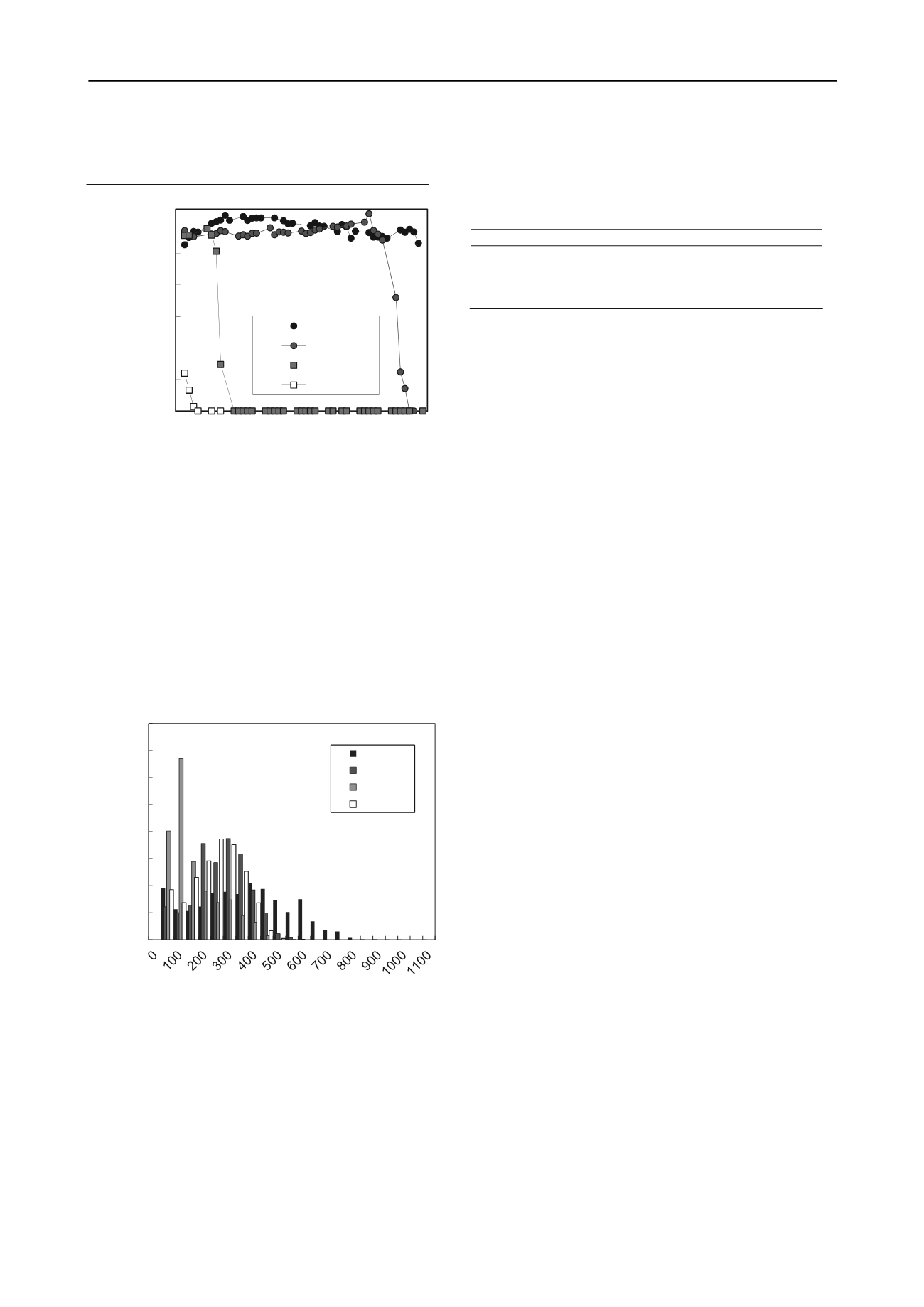
3234
Proceedings of the 18
th
International Conference on Soil Mechanics and Geotechnical Engineering, Paris 2013
Case 3
Pure water supplied for 8 weeks
Case 4
Pure water used for making the model ground and
Pure water supplied for 8 weeks
0.0
0.5
1.0
1.5
2.0
2.5
3.0
0
14
28
42
5
Salinity concentration(%)
Exposed time (day)
6
Case1
Case2
Case3
Case4
Figure 7. Change in salinity during the experiment (sampling location
No. 1-100).
Figure 7 shows how the salinity changed during the
experiments in standpipe No. 1, 100 mm from the bottom of the
sand box. As shown in Table 1, fresh water was introduced
starting at 42 days of exposure time in case 2. The salinity
began to drop within about 1 week after the change and had
almost vanished within 3 or 4 days after that point.
Figure 8 shows the converted unconfined compression
strength distribution in each case. Table 2 shows the maximum
and average strengths and the standard deviation for each case.
The highest strength was observed in case 1, followed by cases
2 and 4, which were similar, and the lowest was in case 3. From
these results, we see that about 2 months of curing time in
seawater is important for accelerated solidification.
0
5
10
15
20
25
30
35
40
Case1
Case2
Case3
Case4
Converted unconfined compression strength (kN/m
2
)
Frequency (%)
Figure 8. Distribution of converted unconfined compression strength.
An unconfined compression strength of more than 100
kN/m
2
is enough to prevent the liquefaction of sandy soil (Zen
et al. 1990). The fractions of data below this level were 15%,
11%, 54%, and 16% in cases 1, 2, 3, and 4, respectively. This
indicates that 80% of PHMT-treated GBFS cured in seawater
for more than 2 months is strong enough to protect against
liquefaction. This conclusion cannot be used to predict
solidification levels in the field, but the results show that this
technique can be used to accelerate the solidification of GBFS.
Finally, a series of permeability tests was conducted on
solidified GBFS specimens in triaxial cells. After the
permeability tests, the samples’ unconfined compression
strength was measured. These tests showed that the coefficient
of permeability decreased with increasing strength. However,
the coefficient of permeability was about 10
-4
cm/sec even when
the unconfined compression strength was about 1000 kN/m
2
,
indicating that the permeability of solidified PHMT-treated
GBFS is about the same as that of ordinary sand.
Table 2
.
Converted unconfined compression strength (kN/m
2
)
Case
Maximum
Average
Standard deviation
1
1060.2
331.4
189.4
2
550.8
244.9
107.9
3
500.7
130.5
99.5
4
493.9
213.4
102.9
4
CONCLUSION
The solidification of GBFS used in port structures can be
accelerated by adding PBFS. However, mixing PBFS with
GBFS presents some issues when used in actual construction
sites. To overcome these problems, we subjected the GBFS to
PHMT treatment. This paper demonstrates the superiority of
this process. PHMT reduces the amount of separation of the
GBFS/PBFS mixture and produces sufficient unconfined
compression strength after about 2 months of curing in
seawater, which occurs automatically when GBFS is used to
backfill quay walls. We conclude that PHMT-treated GBFS
solidifies at an accelerated rate and can be used to prevent
liquefaction.
5
REFERENCES
Coastal Development Institute of Technology. 1989. -
Manual for
granulated blast furnace slag used for port construction
, 71p. (in
Japanese)
Christian, G. D. 1986. -
Analytical Chemistry
, 4th Edition.
Ishihara, K. 2001.
Soil Mechanics
, p.83. (in Japanese)
Kikuchi, Y., Ikegami, M., & Yamazaki, H. 2005. Field investigation on
the solidification of granulated blast furnace slag used for backfill
of quay wall.
Journal of JSCE
No.799/III-72. 171-182.
Kikuchi, Y., Oka, S., & Mizutani, T. 2010. Examining field application
of solidification acceleration method of granulated blast furnace
slag,
Report of PARI
, 49(2). 21-46.
Kikuchi, Y., Nakashima, K., & Mizutani, T. 2007. Acceleration of
Solidification of Granulated Blast Furnace Slag.
13th Asian
Regional Conference
. CD-ROM.
Kikuchi, Y., Nakashima, K., Oka, S., & Mizutani, T. 2011.
Solidification acceleration and solidified shear strength evaluation
of granulated blast furnace slag.
Journal of JSCE
C 67(1). 145-159.
Kikuchi, Y., Nakashima, K., Kimura, J., and Mizutani, T. 2006. -
Solidification of granulated blast furnace slag used for port
construction,
Report of PARI
, 45(2), 105-133. (in Japanese)
Kitayama, N. 2003.
Studies on application of granulated blast furnace
slag to SCP method with low sand replacement ratio
. PhD thesis,
Yamaguchi University, 155p.
Nippon Slag Association. 1980.-
Granulated blast furnace slag -
Technical report on earth work material -
, 63-64. (in Japanese)
Nishi, M., Sato, Y. and Nanbu, M. 1982. - Strength characteristics of
granulated blast furnace slag as a land reclamation material,
Tsuchi-
to-Kiso
, JGS, 30(12), 41-48.
Zen, K., Yamazaki, H., & Sato, Y. 1990. Strength and deformation
characteristics of cement treated sand by premixing method.
Report
of PHRI
, 29(2). 85-118.


